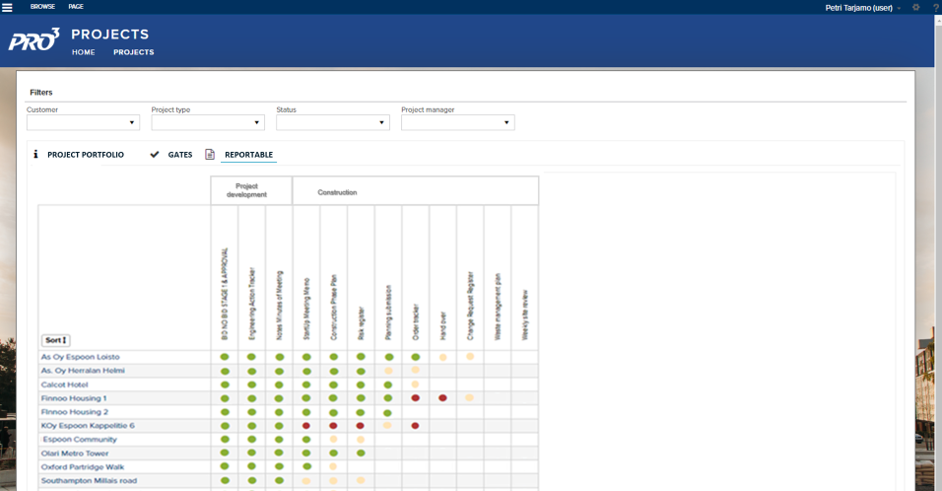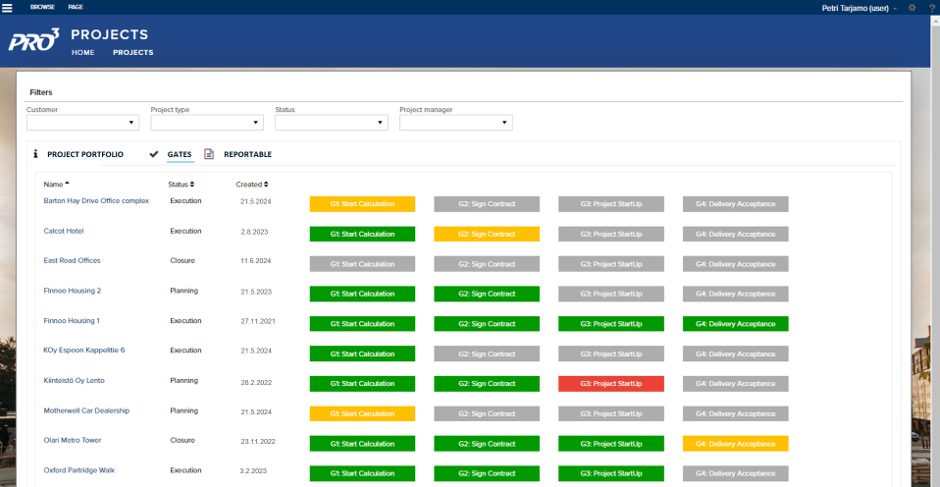(blog by Petri Tarjamo)
Typical challenges in project and information management
Project and Information management have a key impact on project success, customer satisfaction and company profitability. Typical challenges in information management in project activities are:
- Multiple processes and ways of working on projects
- Organization of information management and documentation is deficient or does not work in practice
- Information sharing and its timeliness
- Development outputs and best practices learned cannot be utilized in future projects
- The potential of technology is not sufficiently exploited
The challenges, if realized, will cause extra work and confusion for the project team. This leads to reduced quality, decreased employee and customer satisfaction, and decreased profitability. If project and project-related information is scattered across different people’s own computers and/or network drives and/or SharePoint workspaces and/or multiple channels in Teams, project and project portfolio management becomes more difficult, and risks increase. Competitiveness is lost if lessons learned, and best practices cannot be utilized.
This article focuses on a summary description of the key functions and benefits of Derigo Pro3 project management for the organization, project team and management.
Pro3 Project Management
The Pro3 system is designed to solve the above challenges. It enables the development of project activities piece by piece and brings best practices to future projects. Pro3 collects essential information from projects in a digital and structured format. The work of project teams becomes easier and more efficient, project information management and the quality of project data increase. Project and business management have access to up-to-date information on the status of the project and the entire portfolio. These supports ensuring productivity and anticipating and managing risks. The content, functions, processes, navigation gears, instructions, task and document templates of the Pro3 system always reflect the customer’s way and project model of working n projects, monitoring and guiding projects.
The project workspace guides and supports the work of the project team
The project workspace has all the information the project team needs related to the project in question. Instructions, task and document templates can be easily found and maintained. The project workspace helps and guides project team through the project’s whole life cycle. This means, from sales or project development, through the tender or design and calculation phases to project implementation or construction, and further handover and warranty phase and lifecycle services. Al this according to how the company structures its business and how it is to be described in the Pro3 system. At its simplest, Pro3 controls the process, tasks and documentation. You can also import instructions from the operating system into the workspace, which follows the function navigation, instructing each step according to the company’s policy. Below are a couple of examples.
Sales / Project development

The project workspace guides the sales phase, gathering information and communication related to the customer’s needs and collecting required info for making a winning offer. The project workspace contains the desired quotation and contract templates, pricing and margin calculations, possibly materials related to project and tender reviews, depending on how the company wants.
For a construction company, the name of the phase is typically project/project development, and the content consists of matters related to client negotiations, project planning, plot acquisition, official matters, tasks, documentary, contract and margin calculation templates.
Project Delivery / Construction

In construction, the construction/delivery phase includes, for example, matters related to starting a project, a project plan and other plans, e.g. safety, supervision, control and quality, (building) technology, possible official matters, schedules, etc. according to the project model of the enterprise. Each document automatically receives metadata that links it to business, contract/project type, function, stage, etc. what metadata the company wants to collect from projects. These can be used for searches and summaries.
Project management
Pro3 gathers the key topics related to project management for the project manager and the team on the project dashboard.

Example project dashboard basics tab.
The Master Information tab, or “One Pager”, gives you an overview of what kind of project you’re talking about. It gathers project information relevant to the organization.

Example of a reporting tab in a project dashboard.
The Reporting tab indicates the status of matters defined for monitoring and reporting in accordance with the company’s project model, such as tasks or documentation. What things have been assigned to the type of project according to the company’s model, which ones have already been done, and what needs to be done next. As standard, Pro3 includes basic information and reporting tabs for tasks and documents. Many customers bring information from other systems to the project dashboard. Typical are financial data, occupational safety measurements, and other relevant information.

Example of Pro3 homepage.
The Pro3 front page informs the user briefly about the projects they are running or monitoring, as well as the tasks assigned to them in different projects, listed according to the due date. The front page gives you a quick overview of what’s going on. Correspondingly, support function specialists also receive an email alert for the tasks assigned to them. The front page also contains links to the project library or portfolio, portfolio report and other information systems and information sources supporting the company’s operations and projects.
- What do I have going on, what projects, what tasks
- What’s new in them, new documents, updates, etc.
- The tasks assigned to me, from all projects and phases, are gathered in one list
- Pro3 also compiles user-edited documents into a single list
Project portfolio monitoring and management
Pro3 gathers basic information about each project, e.g. project name, number, business, project/contract type, object/customer, scope of the project (euros, etc. criteria), depending on how the company structures its business. Project data (metadata) is used in the formation of the portfolio as well as in the formation of the data stored for the projects, e.g. as metadata of documents and in various summaries.

The project library lists all projects structured according to the desired criteria.

Project library in GANTT view.
Portfolio report

Example portfolio report dashboard.
The portfolio report compiles the status of the projects and structures the portfolio according to how the company wants to monitor the business. The breakdown can be by business area, project and/or contract type, project stage, etc. Filters can be used to quickly get different views according to the projects and/or project types of businesses and/or units.
The topics to be monitored are, in accordance with the company’s operating model and management system, a combination of the following:
- Tasks
- Documents
- Procedures (i.e. a set consisting of 1-n tasks and 1-n documents)
- Decisions (e.g. decision to tender, contract review, project start or approval of project plan, approval of cost estimate, etc.)
Pro3 compiles the status of projects from the perspective of decision-making, project status tasks and documentation. When this is combined with information on income and costs produced by other systems, such as ERP, in relation to budget and targets, the management has an up-to-date situational picture to support management and decision-making.

An example of tracking portfolio report documentation.
The monitoring of tasks and procedures can also be built into a similar model.

Example of managing closing points in a portfolio report.
Benefits of Pro3 for your organization
According to our customers, the key benefits of Pro3 are: (source. Derigo’s customer survey for management and users 2023)
Project organization – smoother everyday life and time savings
- The information, instructions, documentation needed to make the project are easily available
- The status of the project and what others have already done in the same project are always clear
- Quality is part of daily work and not patching up afterwards in connection with audits
Operational management – makes management easier
- Better control of the project portfolio
- We know what happens in projects and what stage they are at
- It’s easier for people to move between projects and onboard
- Project risks are better managed
- Pro3’s follow-up views support management
Top management – up-to-date situational awareness of project activities
- Quick overview of project business status
- Traffic light monitoring of key decision/monitoring points
- A tool for internal communication and management and putting into practice the operating method defined through the strategy
Pro3 quickly delivers tangible benefits
Derigo Pro3 is a predictable and safe investment. The implementation project is fast and fixed-priced, and the service fees are determined by the scope of the system and the number of users. Service fees are scalable, initially you can work with a smaller team and expand according to your business needs.
Derigo Ltd has extensive experience in project management and implementation projects. Implementation focuses on the customer’s business and way of working on projects. Quick implementation brings quick benefits – the project team saves time, critical project information is in one place, and information related to project and business management is available in real time.
Pro3 is also an excellent tool for implementing the desired operational change and training new people. Pro3 is available both from a computer, as well as a mobile-optimized interface that scales to mobile devices (Android and iOS).
With the implementation, the customer’s main users will have the competence to maintain and further develop the operating model and content with Pro3’s admin tools. The customer can maintain the content themselves, describe new processes and content for them. The system can be used to guide and support sales and account management activities, delivery projects in multiple industries (construction, building automation, technology etc.), maintenance services and internal development projects.
Access rights can be managed according to the customer’s user groups and policy, also through Azure AD integration. The system can also have more than one business function or company. From the point of view of user licenses, the number of users is calculated from all BU’s/companies together and pricing according to the corresponding level. If your parent company is interested, Pro3 is also available in different language versions. How to do the trick in practice? That is, how can I enable Pro3. About that in the next write-up.




Ei kommentteja vielä